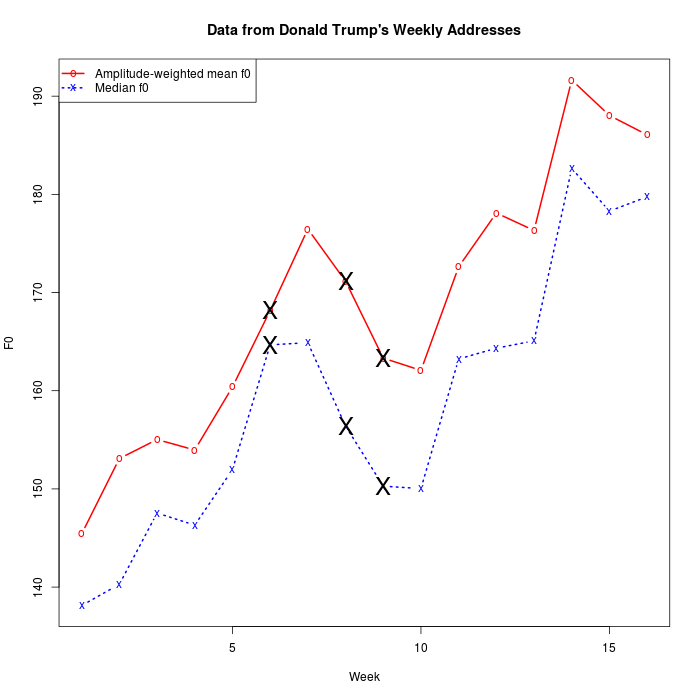Trends in presidential pitch
« previous post | next post »
I've been downloading the audio for Donald Trump's Weekly Addresses from whitehouse.gov, as I did for George W. Bush and Barack Obama. And as I did for the previous presidents, I listen to the results and sometimes do simple acoustic-phonetic analyses — see e.g. "Raising his voice", 10/8/2011; "Political sound and silence", 2/8/2016. Recently I thought I noticed a significant change in Mr. Trump's pitch range, and a quick check confirmed this impression.
There are several different kinds of reasons for a change in a speaker's f0. Some are external, like higher background noise levels or a larger or more distance audience, while others are internal, for example reflecting the speaker's level of physiological arousal. (See e.g. "Political pitch ranges" 4/22/2015, "MLK Day: Pitch range" 1/16/2017, etc.)
In this case, a quick check of the audio and video shows that there the external context is different for weekly address #6 (3/3/2017), which was delivered on board the U.S.S. Ford; and that weekly addresses #8 and #9 are full of music and news clips in addition to the president's voice, and therefore should be ignored. So I've added big X's on those three data points.
1. 20170128
2. 20170203
3. 20170210
4. 20170217
5. 20170225
6. 20170303 [Different context — on board the Gerald R. Ford]
7. 20170310
8. 20170325 [Differently produced… background music etc.]
9. 20170331 [Differently produced… background music etc.]
10. 20170407
11. 20170414
12. 20170421
13. 20170428
14. 20170505
15. 20170512
16. 20170519
But the rest of the addresses were read from teleprompters in similar contexts in the White House — compare the addresses for 1/28 and for 5/12:
It's possible that the apparent trend has been caused by some gradual changes in the recording set-up. But the median f0 has changed from 138-140 Hz in the first two Weekly Addresses, to 183-178 Hz in the most recent two. That's a change of 30%, or 4.5 semitones, which is a lot to result from modest differences in recording set-up for scripted readings in what should be identical communicative contexts.
Update — data from 5/19/2017 added.

Guy said,
May 19, 2017 @ 11:24 am
I wonder how much can be attributed to simply acclimating to the regularity of the addresses. This is a wholly subjective evaluation but I feel like in the 1/28 address he is trying to sound more solemn and formal and in the 5/12 he sounds more relaxed.
chh said,
May 20, 2017 @ 10:25 am
This is interesting! Is the purpose of the amplitude weighted mean to try and separate out the influence on F0 of how loud the speaker is talking?
[(myl) No — it's much more simple-minded than that. Among the many problems that can afflict pitch-tracking is a scattering of point in regions of speech where voicing is not well established. These regions are often lower in relative amplitude, so weighting f0 estimates by relative amplitude tends to discount their effect on an overall average. Using the median rather than the mean is another (and more standard) way to deal with such outliers. As you can see, the two methods show just about the same pattern of changes in this case.]
How helpful is it to use an amplitude-weighted mean when you're comparing recordings that not only may have been set up differently, but were each presumably mixed and normalized as well? Isn't it possible Trump was speaking significantly louder throughout the second clip but that the amplitude levels of the audio signal don't reflect that?
[(myl) The overall amplitude of recorded audio tells us nothing about the sound level of the original signal, since it depends on the initial recording conditions and on subsequent processing.]
Is there a Lombard-like effect for when you're pretty sure none of the listeners trust you?
[(myl) There's certainly a tendency to talk louder when you believe that your listeners will have a harder time understanding you. I don't know of any studies of the effects of perceived mistrust, and my guess is that the results would be variable.]
Jonathon Owen said,
May 24, 2017 @ 1:52 pm
This can only mean one thing: Trump is evolving into a Neanderthal.